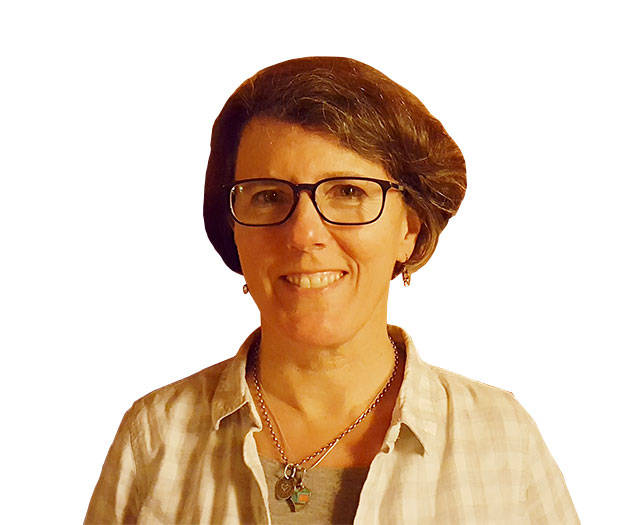Last month the topic of this column wasn’t water, but recycling. I gave in to my fascination and wrote about the wicked problem of expanding waste piles and how to quickly form new markets for recycling. I planned to justify myself this month by comparing the well-known water cycle to the growing “circular economy” involving global waste.
However, I interrupt this not-totally unforced topic for a huge announcement: The Dungeness off-channel reservoir project just landed a $4 million grant!
In case you haven’t heard of it, this project will create a large water storage reservoir on forest land at the high end of the watershed. Stored water will be released for irrigation purposes to replace withdrawals from the Dungeness River during low-flow season when salmon are trying to spawn.
During winters with plentiful snow in the Olympics water would also be stored and released for the purpose of recharging the shallow aquifer.
As a hydrogeologist, I am very keen on the potential of this opportunity since our regional water table has declined due to changing water management practices over the past few decades.
More than five years ago, City of Sequim and a dozen other water managers and decision makers in eastern Clallam County partnered to actively strategize and pound the pavement to find the right source of funding for the reservoir project proposal.
The recent $4 million grant is the first awarded to the partners of several attempts, and allows for Phase 1, forest land transfer from the state Department of Natural Resources to Clallam County Parks, as well as Phase 2, the final engineering and permitting necessary before proceeding to Phase 3, construction.
Finding funding for the anticipated $20-30 million construction project, when that time comes, will be yet another exercise in leaving no stone unturned. Which gives me an idea: Perhaps if everyone in support of the project volunteered to turn some actual stones — enough for an 88-acre hole — we could save a lot of money on excavators!
Last but not least, paying for reservoir operations and ongoing maintenance will require additional creativity, with beneficiaries of the water releases needing to help foot the bill.
Fortunately, the list of project benefits is long and touches stakeholders from Sequim to Olympia and beyond.
In addition to farming, fisheries, and the shallow aquifer, benefits include avoidance of flooding from stormwater entering city limits, recreation in a new 400-acre county park and long-term resiliency against decreasing water supplies due to climate change.
Project partners include the Agricultural Water Users Association (irrigation managers), Clallam County, City of Sequim, Jamestown S’Klallam Tribe, Clallam Conservation District, and Washington Water Trust.
For details please refer to a fact sheet and video available from several project websites such as www.sequimwa.gov/759/Dungeness-Off-Channel-Reservoir.
Back to cycles and circles
Checking the premise I made last time that the water cycle is a good example of a circular economy—let’s see if it holds water.
Simplistically speaking, a circular economy differs from the traditional, linear model of resource management in that the phases of production, utilization, and waste are connected rather than coming to a halt when humans are done using the resource or product.
The water cycle, with its main components of evaporation, precipitation, runoff and transpiration by plants is certainly an elegant model of a circular economy. But it’s unique in that water is both naturally renewable as well as limited: people can’t produce “new” water, at least on a global scale. We are forced to take care of the limited supplies of fresh water available to us now.
Exploring the circular water economy more fully is tempting, given that water is indeed a “good” as well as a “service.” The emerging science of determining the economic value of cascading benefits to society from ecosystem services provided by streams, aquifers, wetlands, and natural resources is fascinating … but that journey will have to wait for “Circles and Cycles, Part III.”
We’re now enlightened enough to know that most resources are not without limit. Circling around by recycling water as well as our waste makes good sense.
Geek Moment
Snow matters! As I write this from my dining room at 1,700 feet elevation, it is 20 degrees outside and there is about 12 inches of lovely fluff draped all over the world outside my French doors. I am waiting for the plow to clear our road (and tow trucks to clear the ditches) before trekking to the office.
A month ago I said we needed cold temps above 4,000 feet to make up for low snow accumulation in December and January. That’s still true!
For the 2019 Water Year (started Oct. 1):
• Rain in Sequim through Feb. 4, 8 a.m.: At the Sequim 2E weather station (Schmuck Road): Total rainfall = 8.3 inches; Highest temp. = 65 deg. F on Oct. 13; Lowest temp. = 19 deg. F on Dec. 6
• Snow in the upper Dungeness watershed through Feb. 3, midnight: Reported for the SNOTEL station (elev. 4,010 feet): Snow depth = 6 inches; Snow water equivalent = 2.1 inches (45 percent of normal). Cumulative precipitation is normal. Number of days temp. stayed below freezing = at least 1 (not all data is available)
• River flow at the USGS gauge on the Dungeness (Mile 11.2): Maximum flow = 1,870 cubic feet per second (cfs) on Nov. 27; Minimum flow = 77 cfs on Oct. 25. Currently (Feb. 4, 10 a.m.): 274 cfs
• Flow at Bell Creek entering Carrie Blake Park: Flow = a trickle (0.5 cfs); Bell Creek at Washington Harbor = flow generally 2-5 cfs in winter, unless it’s storming
Ann Soule is a hydrogeologist immersed in the Dungeness watershed since 1990, now Resource Manager for City of Sequim. The opinions expressed are those of the author and do not necessarily represent policies of her employer. Reach Ann at columnists@sequimgazette.com or via her blog at watercolumnsite.wordpress.com.



